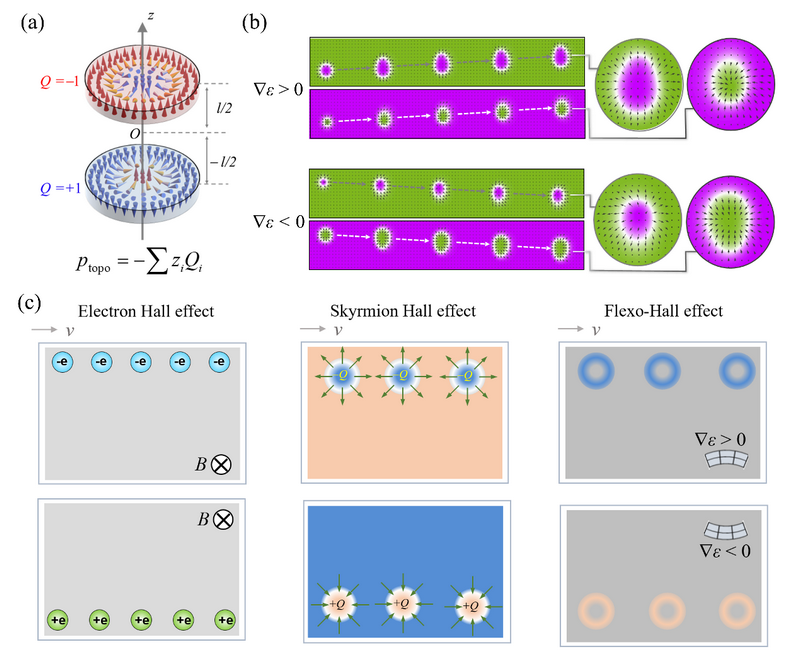Flexomagnetic effect, which refers to the coupling between magnetism and strain gradients, is a novel kind of magnetoelastic effect and has raised extensive attentions in interdisciplinary field of physics, mechanics, material science and electronics?engineering. It holds promising application potential in developing novel devices like sensors, actuators and energy harvesters towards miniaturization and low-power consumption. However, the intrinsic flexomagnetic effect is generally weak in traditional magnetoelastic materials for the different symmetry requirements of strain gradients and ferromagnetism that strain gradients break the space-reversal symmetry while ferromagnetism is a time-reversal symmetry breaking product. The misfit in symmetry has been the bottleneck in development of related physical mechanisms and devices. Recently, Prof. Yue Zheng’s group has realized a strong coupling between strain gradients and magnetism via a spatially asymmetric interaction called Dzyaloshinskii-Moriya interaction (DMI). The reported effective flexomagnetic coefficient is 4 orders larger than that predicted in previous work. This research is likely to open a new avenue for giant flexomagnetic effect and developing relative devices.

Figure 1:Flexomagnetic effect: (a) Distributions of DMI vectors for cases of different strain states. (b) Dependence of the net magnetization on strain gradients based on simulation. (c) Topological enhanced effects of the effective flexomagnetic coefficients.
In this research, Prof. Yue Zheng's group from the School of Physics at Sun Yat-sen University establishes the internal connection between magnetism and strain gradients via the asymmetric DMI in antiferromagnetic multilayers system hosting skyrmions. Result indicates that the DMI vector will rotate around the bending direction and furtherly affect the net magnetization of the system. Additionally, the produced flexomagnetic effect exhibits a notable size dependence, which will largely improve the overall magnetoelastic effect when the system scales down. Based on that, they predicted the detailed dependence of the net magnetization and deformation of skyrmion on strain gradients.
In addition, the authors have also revealed the novel magnetic transport characteristics caused by the strain gradient. They showed that the skyrmions would exhibit a nontrivial Hall effect with the Hall ratio dependent on the strain gradient direction. They theoretically proved that the anomalous Hall deflection of skyrmions is originated from geometric Magnus forces caused by strain gradients and such effect is named as ‘flexo-Hall’ effect. This work therefore provides a new physical mechanism to enhance flexomagnetic coupling in magnetic systems by hosting topological structures and predicts a flexo-Hall effect in such systems. This is the first time to reveal these important effects and the hidden physics and may open up a new field -“flexoskyrmionics”.

Figure 2:Flexo-Hall effect: (a) Schematic illustration of synthetic antiferromagnetic skyrmion. (b) Simulation result of current-driven transport of skyrmions under various strain gradients. (c) Schematic illustration of electron Hall effect, skyrmion Hall effect and flexo-Hall effect, where the deflection direction depends on electrical charge, topological charge and the sign of strain gradients, respectively.
This research was online published in Physical Review Letters entitled “Flexoresponses of Synthetic Antiferromagnetic Systems Hosting Skyrmions” on June 21st, 2022. This work is independently completed by Sun Yat-sen University with the School of Physics as the first unit. The cooperation units include Guangdong Provincial Key Laboratory of Magnetoelectric Physics and Devices, State Key Laboratory of Optoelectronic Materials and Technology and School of Materials. Linjie Liu, a doctoral student of the School of Physics, is the first author, Professor Zheng Yue and Associate Professor Weijin Chen are the corresponding authors. The research was supported by the key R&D plan of the Ministry of science and technology, the key projects of the National Natural Science Foundation of China and the National Supercomputing center in Guangzhou.
Link to the paper: http://link.aps.org/doi/10.1103/PhysRevLett.128.257201
